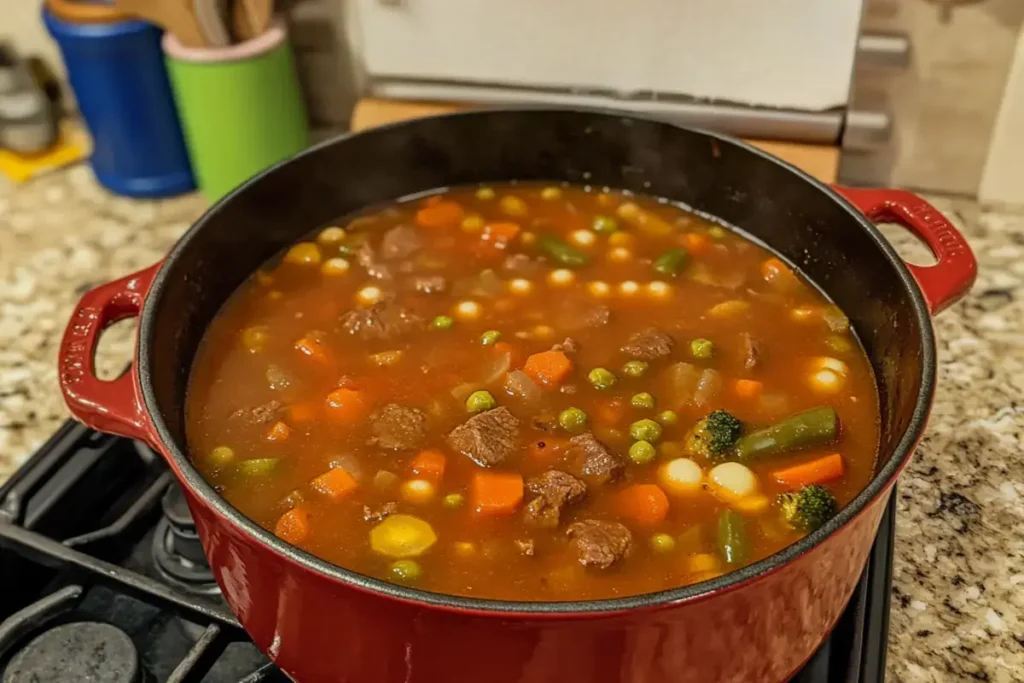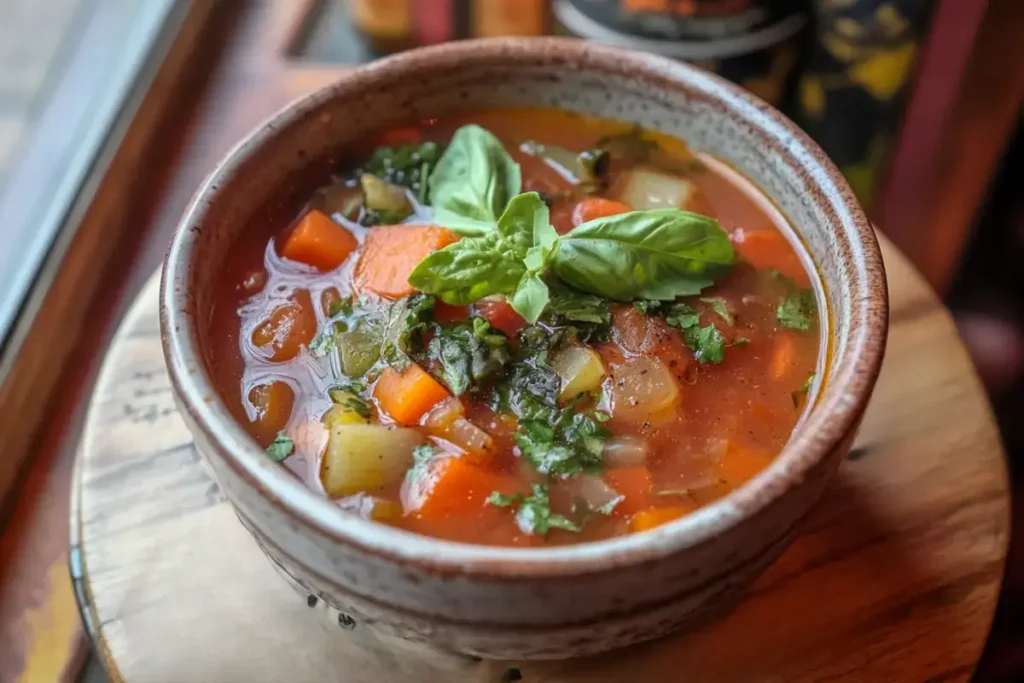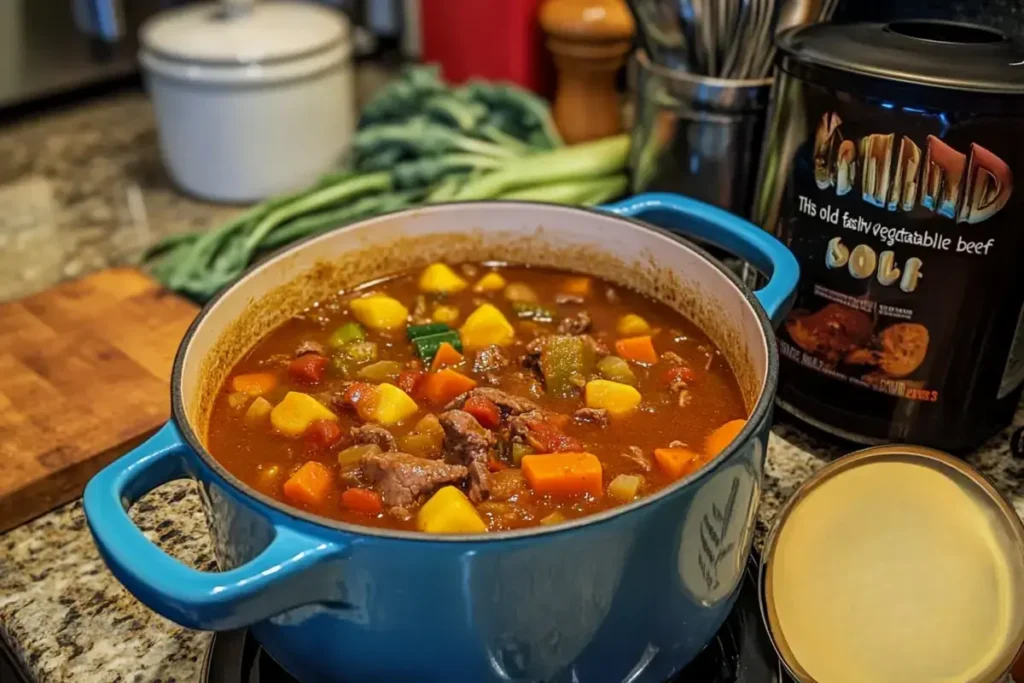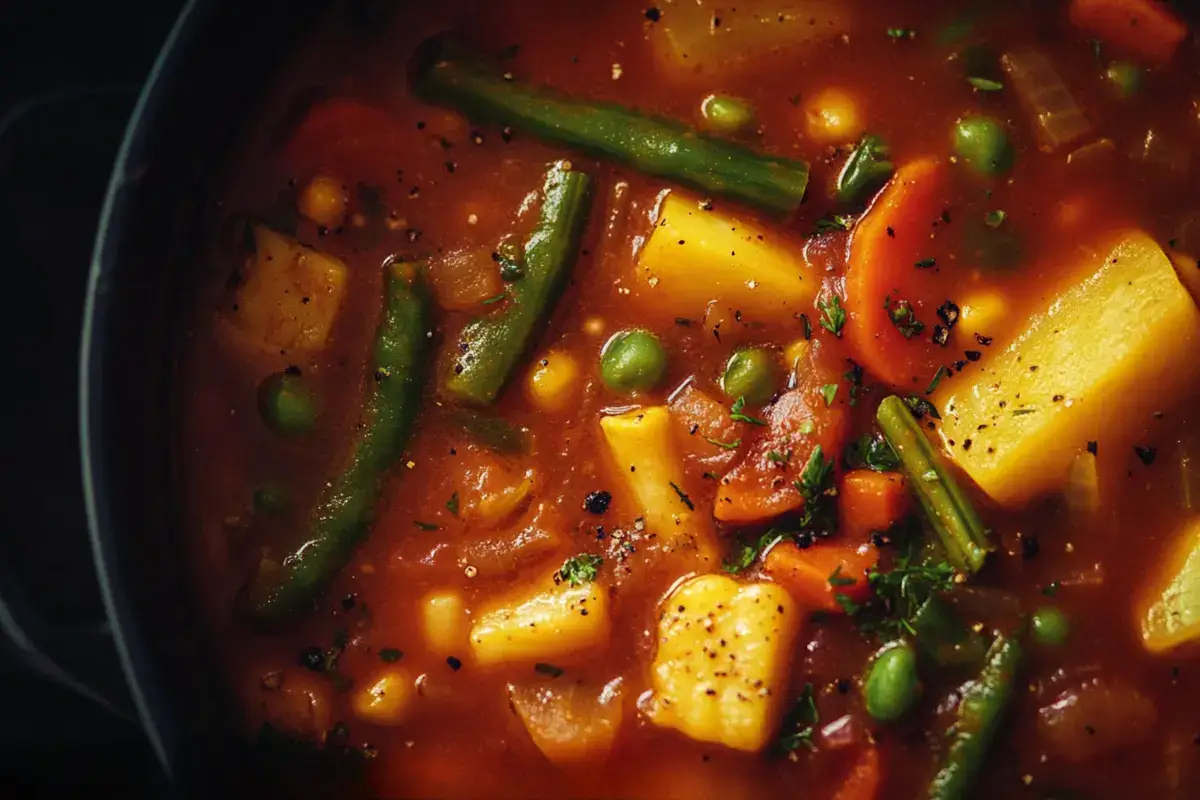Elevate your vegetable soup with savory tips, herbs, and cooking techniques for unbeatable depth of flavor in every spoonful.
Welcome to an in-depth exploration of how to add depth of flavor to vegetable soup? A flavorful soup can turn a simple meal into a comforting masterpiece. Comparatively, many home cooks find their vegetable soups taste flat or watery. However, a few strategic techniques can transform your soup pot into a wellspring of savory taste and satisfying texture. In this article, you will learn every tip and trick you need to maximize flavor, from selecting produce to adding a brilliant final garnish. Eventually, you’ll develop the confidence to create vegetable soups brimming with gusto.
The Basics of Flavorful Vegetable Soup
A hearty vegetable soup begins with the basics. Basically, you need fresh, high-quality vegetables for maximum impact on taste and nutrition. Choose produce that is crisp, colorful, and free of blemishes. Indeed, fresher vegetables contain more natural sugars that develop into a sweeter, deeper flavor when cooked. For example, carrots and onions grown locally or in season often have a richer taste than older vegetables transported across vast distances.
Another foundation of soup-making involves creating a flavor base. Traditionally, many classic soups start with a mirepoix. This is a mixture of diced onions, carrots, and celery sautéed in a bit of fat. Chiefly, the key to unlocking these flavors is cooking them until they soften and release their natural sugars. Conversely, rushing this step can prevent your soup from achieving a truly elevated taste.
Using the right fats is equally important for carrying and blending flavors. Olive oil, avocado oil, or even a small amount of butter can work wonders. Initially, heat the fat in your pot and then add the chopped aromatics. Stir them gently to create a foundation of taste that will infuse the rest of the soup. This fundamental step prepares the stage for how to add depth of flavor to vegetable soup? in subsequent phases.
The Fundamentals
Important Steps in How to add depth of flavor to vegetable soup?
Layering flavors is critical. Subsequently, cook each ingredient in stages to ensure the flavors develop fully. For example, add onions early enough to caramelize slightly before introducing carrots, celery, or bell peppers. Consequently, every vegetable gets enough heat exposure to deepen its color and taste. Likewise, using herbs and spices at varied stages—initially and again near the end—helps maintain brightness and complexity.
- Add robust spices at the start. This ensures spices toast slightly in the oil, releasing essential oils.
- Introduce fresh herbs at the end. This captures their fragrant, fresh flavor without letting heat degrade their delicate oils.
The approach you take when adding these elements can make or break how to add depth of flavor to vegetable soup? Indeed, it is a deliberate process of layering tastes and aroma so the final product shines with complexity.
In terms of herbs and spices, experiment with both fresh and dried options. Dried herbs are typically more concentrated, so start with a smaller amount to avoid overpowering the soup. Basil, thyme, oregano, and bay leaves are common choices for building robust taste. Nonetheless, fresh dill, parsley, or chives can add a delightful pop of color and flavor near the end.
Stocks and Broths
When exploring how to add depth of flavor to vegetable soup?, you cannot ignore the importance of a quality broth. Generally, you have two main options: store-bought or homemade. Store-bought versions are convenient, but homemade stock adds a luxurious mouthfeel and distinctive taste. Particularly, simmering vegetable scraps (like carrot ends, celery leaves, and onion peels) in water with herbs or spices yields a stock that intensifies the eventual flavor of your soup.
Moreover, umami-rich ingredients can take your vegetable soup to the next level. Shiitake mushrooms, kombu (seaweed), or a spoonful of miso paste contribute a savory depth. Because umami is often described as the “fifth taste,” it can provide that elusive, restaurant-quality flavor. If you’re short on time, add a splash of soy sauce, nutritional yeast, or Worcestershire sauce (if not strictly vegetarian) to imitate that rich, hearty note.
Balancing salt is equally crucial. Salt doesn’t just make food salty; it highlights existing flavors. However, be cautious when using store-bought stock, as it may already contain sodium. Taste as you go. Eventually, you’ll find the perfect balance.

Key Seasonings & Herbs
Seasonings and herbs are the backbone of any good soup. Chiefly, they can transform plain vegetables into a harmonious medley of flavors. While salt is vital, other seasonings play equally significant roles in how to add depth of flavor to vegetable soup?
Cooking Techniques
- Sautéing: Initially heat oil, then add onions, garlic, or leeks. Cook until translucent or golden. This creates a sweet, caramelized layer.
- Deglazing: After sautéing, pour in a small amount of wine, vinegar, or broth. Scrape the browned bits from the bottom of the pot for extra flavor.
- Roasting: Spread vegetables on a baking sheet, drizzle with oil, sprinkle with salt, and roast until browned. Meanwhile, the natural sugars in vegetables intensify.
- Slow-Cooking: A slow cooker or a gentle simmer helps flavors meld together over time. Comparatively, a pressure cooker speeds up this process but retains depth.
Spices such as smoked paprika, chili powder, curry blends, or even garam masala can introduce a global twist. Indeed, exploring international seasonings broadens your soup’s flavor palette. Mediterranean blends often focus on oregano, thyme, and rosemary. Asian-inspired soups might include ginger, soy sauce, and star anise. Latin flavors may incorporate cumin, coriander, and cilantro. Each approach offers a new perspective on how to add depth of flavor to vegetable soup? so experiment enthusiastically.
Roasting and Other Flavor-Enhancing Methods
Roasting is often overlooked for vegetable soup, but it can profoundly influence the flavor. Specifically, roasting vegetables like tomatoes, bell peppers, butternut squash, or even onions brings out their natural sugars. That caramelized sweetness complements savory notes nicely. Afterward, these roasted vegetables can be puréed or added in chunks. Either way, the roasted essence will permeate the soup.
Caramelization is another powerful method. Caramelizing onions or mushrooms until they turn deep golden brown creates a strong, sweet-savory element. Eventually, those flavors spread throughout your soup, giving it a restaurant-worthy depth.
Slow-cooking techniques also work wonders. A slow simmer melts all the flavors together gently. Meanwhile, a pressure cooker speeds things up but can still extract robust tastes from aromatics, vegetables, and herbs. Be sure to adjust your liquids, as pressure cooking generally requires less water due to reduced evaporation.
Finishing Touches
Finishing touches can make all the difference when focusing on how to add depth of flavor to vegetable soup? These subtle additions can elevate a decent soup into an outstanding one.
Common Mistakes
A few typical errors can harm your soup’s flavor potential:
- Overcooking vegetables: Eventually, they lose texture and vibrant color. Cook them until just tender for best results.
- Waiting too long to season: Salt added at the beginning of cooking penetrates ingredients more thoroughly. Nonetheless, always taste at the end to fine-tune.
- Skipping acid: A splash of lemon juice, vinegar, or wine brightens the entire dish.
- Forgetting garnishes: Fresh herbs, toasted seeds, or a drizzle of flavored oil can create a final flourish of complexity.
Adding an acidic element is especially helpful. Lemon juice or a dash of vinegar cuts through any heaviness, highlighting your soup’s layers. Likewise, consider stirring in a small amount of cream, coconut milk, or sour cream to add richness. Some cooks swirl in a dollop of pesto or a drizzle of chili oil to achieve a perfect balance between tangy, creamy, and spicy.
Garnishes can also transform the meal’s presentation. Parsley, basil, or cilantro introduced just before serving keep a bright, fresh note. Toasted nuts or seeds lend crunch and a nutty dimension. Even a sprinkle of Parmesan or vegan cheese can add umami and round out the soup’s taste. These finishing touches are vital to mastering how to add depth of flavor to vegetable soup?

Troubleshooting a Bland Soup
Sometimes, no matter how many steps you take, your soup might still lack punch. In that case, thoroughly taste your soup while it’s cooking. If it’s bland, add small increments of salt or other flavor boosters like soy sauce, Worcestershire sauce, or tomato paste. Tomato paste brings sweetness and tang, while soy sauce or Worcestershire sauce adds a savory depth. Nutritional yeast offers a cheesy, umami-rich note if you’re keeping things vegan.
When adjusting the taste:
- Salt gradually: Salt can’t be undone if you overshoot.
- Test acidity: A mild acid can make flavors pop.
- Check sweetness: Adding a small amount of honey, maple syrup, or sugar can balance excess acidity or bitterness.
Because you can adjust your soup’s flavor at almost any stage, it pays to taste frequently. Chiefly, pay attention to seasoning after adding more broth or water, as this can dilute your soup’s salt level. Remember, layering is the essence of how to add depth of flavor to vegetable soup? so incremental adjustments can keep you on track.
Health and Dietary Considerations
Trying to reduce sodium intake? You can still enjoy a tasty soup without over-salting. Consider adding more herbs, spices, and umami-rich ingredients. Additionally, using a homemade stock with minimal salt gives you more control. If you want extra protein, beans, lentils, or tofu are great plant-based solutions. They absorb the flavors around them and boost satiety.
Meanwhile, do not overlook healthy fats. A bit of olive oil or avocado oil adds mouthfeel and helps your body absorb certain nutrients. You might also finish your soup with a swirl of yogurt or a plant-based alternative. This approach offers both creaminess and a nutritional boost.
Vegans or vegetarians can use miso, mushroom powder, or nutritional yeast to mimic the savoriness of meat-based broths. Likewise, roasted vegetables provide a hearty dimension that satisfies even without any animal products. Undoubtedly, these strategies can enrich your understanding of how to add depth of flavor to vegetable soup?
Cultural Approaches to Vegetable Soup
Soups vary widely across cultures, offering diverse insights on how to add depth of flavor to vegetable soup? For example, Mediterranean-style soups often rely on garlic, onions, tomatoes, and olive oil. The combination of basil, oregano, and thyme conjures a taste reminiscent of the sunny coasts.
- Asian-Inspired: Ginger, soy sauce, miso, sesame oil, and scallions build deep, savory flavors. Add bok choy or mushrooms for variety.
- Latin Flavors: Include cumin, coriander, chili powder, and fresh cilantro. A hint of lime can brighten these bold spices.
- Middle Eastern: Combine spices like cumin, turmeric, and cinnamon with chickpeas and fresh herbs like mint or parsley.
By examining these global spins, you’ll uncover many creative approaches to infuse your soup with character and complexity. Altogether, it’s about harnessing an array of ingredients that work together harmoniously.

Frequently Asked Questions
How can I deepen my soup flavor?
To deepen your soup flavor, focus on building layers. Sauté onions, garlic, and carrots first. Then, deglaze with broth or wine to capture any browned bits. Use quality stock, either homemade or low-sodium store-bought. Season as you go, and don’t forget a splash of acid or a pinch of sweetness toward the end.
How do you fix tasteless vegetable soup?
If your soup is tasteless, taste it carefully and add salt gradually. Incorporate umami boosters such as soy sauce, tomato paste, or nutritional yeast. If it’s too acidic, add a small pinch of sugar or drizzle of honey. Finish with fresh herbs, citrus zest, or a dab of butter for extra richness.
What gives vegetable soup that depth of flavor?
Depth of flavor comes from several sources. Caramelized aromatics, robust broths, and strategic seasoning all play a role. Sauté vegetables thoroughly, use homemade or high-quality stock, and incorporate umami-rich elements like mushrooms or miso. A final sprinkle of fresh herbs or citrus zest can amplify these layers.
How to enhance the flavor of vegetable soup?
Enhancing the flavor involves cooking ingredients properly, seasoning in stages, and adding final touches. Roast vegetables for sweetness, simmer with herbs, and use a splash of acid for balance. A swirl of cream or coconut milk can add richness, while garnishes like fresh herbs or toasted nuts provide texture and aroma.
Conclusion
Learning how to add depth of flavor to vegetable soup? starts with small steps that add up. You begin by selecting the freshest produce, then sautéing aromatics in flavorful fats, and layering your seasonings throughout. Gradually, you incorporate quality stock or umami-rich boosters. Finally, finishing touches like a splash of citrus or a swirl of cream bring everything together. Whether you’re following a Mediterranean, Asian, or Latin flavor profile, the principles remain the same: build flavors patiently, taste often, and balance every element.
Altogether, a well-executed vegetable soup transcends its humble reputation. You’ll craft a dish that feels hearty, comforting, and deeply satisfying. So go ahead, experiment with various vegetables, cooking methods, and spices. Eventually, you’ll master how to add depth of flavor to vegetable soup? and elevate every bowlful you serve.

